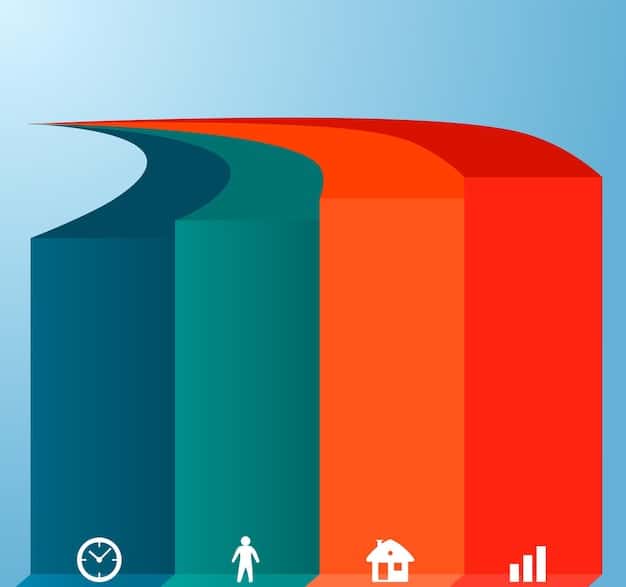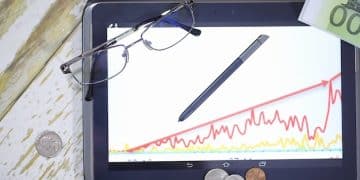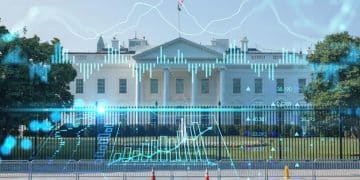Fact Check: Has Inflation Really Decreased by 2% in the Last Quarter?

Fact Check: Is the Claim That Inflation Has Decreased by 2% in the Last Quarter True? Examining recent economic data and reports, this fact check analyzes the claim that inflation has decreased by 2% in the last quarter, providing insights into the accuracy and implications of this statement.
Is inflation finally cooling down? Recent claims suggest a significant 2% decrease in inflation over the last quarter, but is this too good to be true? Let’s delve into the data and separate fact from fiction when addressing the Fact Check: Is the Claim That Inflation Has Decreased by 2% in the Last Quarter True?.
Understanding Inflation and Its Measurement
Inflation is a critical economic indicator that reflects the rate at which the general level of prices for goods and services rises, and subsequently, purchasing power falls. Measuring inflation accurately is essential for informed economic analysis and policy-making.
Key Inflation Metrics
Several key metrics are used to measure inflation, each providing a different perspective. The Consumer Price Index (CPI) and the Personal Consumption Expenditures (PCE) price index are two of the most widely used.
Understanding these metrics and their reporting frequency can help in evaluating the claim that inflation has decreased by 2% in the last quarter.
- Consumer Price Index (CPI): Measures the average change over time in the prices paid by urban consumers for a basket of consumer goods and services.
- Personal Consumption Expenditures (PCE) Price Index: Measures the prices that people living in the United States pay for goods and services. It is the primary inflation index used by the Federal Reserve.
- Producer Price Index (PPI): Measures the average change over time in the selling prices received by domestic producers for their output.
These indices provide a comprehensive view of price changes across various sectors of the economy, allowing economists and policymakers to track inflation trends and make informed decisions.

Examining the Claim: 2% Decrease in Inflation
The claim that inflation has decreased by 2% in the last quarter warrants careful scrutiny. To evaluate this statement, we need to consult reliable economic data sources and compare the figures with previous periods.
Data Sources for Inflation Analysis
Reliable data sources are essential for verifying any claims about inflation. Government agencies like the Bureau of Labor Statistics (BLS) and the Bureau of Economic Analysis (BEA) are primary sources of inflation data.
Independent economic research institutions and financial news outlets also provide valuable analysis.
- Bureau of Labor Statistics (BLS): Publishes the Consumer Price Index (CPI) and Producer Price Index (PPI).
- Bureau of Economic Analysis (BEA): Publishes the Personal Consumption Expenditures (PCE) Price Index.
- Federal Reserve (Fed): Provides monetary policy reports and economic forecasts that include inflation analysis.
By consulting these sources, one can gain a comprehensive understanding of inflation trends and verify the accuracy of the 2% decrease claim.
Analysis of Recent Economic Reports
Recent economic reports offer valuable insights into the current state of inflation. These reports provide the raw data and analysis needed to assess whether inflation has indeed decreased by 2% in the last quarter.
Key Findings from CPI and PCE Data
Analyzing the latest CPI and PCE data is crucial. These reports provide a detailed breakdown of price changes across various categories.
It’s important to look at both the headline inflation rate and the core inflation rate (excluding food and energy) to get a clear picture.
Expert Opinions on Inflation Trends
Economists and market analysts often offer their perspectives on inflation trends. Their insights can provide context and help interpret the data.
Divergent opinions among experts highlight the complexities of inflation forecasting.

Factors Influencing Inflation Rates
Inflation is influenced by a variety of factors, both domestic and global. Understanding these factors is essential for interpreting inflation trends and assessing the likelihood of sustained decreases.
Supply Chain Dynamics
Supply chain disruptions have played a significant role in recent inflation. Bottlenecks and shortages can drive up prices.
Improvements in supply chain efficiency can help alleviate inflationary pressures.
Monetary Policy and Interest Rates
The Federal Reserve’s monetary policy has a direct impact on inflation. Raising interest rates can help cool down the economy and reduce inflation, but it can also slow economic growth.
Global Economic Conditions
Global events, such as fluctuations in oil prices and international trade policies, can also influence inflation rates.
Potential Impact of a 2% Inflation Decrease
If inflation has indeed decreased by 2% in the last quarter, the potential impact on consumers and the economy could be significant. Lower inflation can lead to increased purchasing power and improved economic stability.
Benefits for Consumers
Lower inflation means that consumers’ money goes further. They can purchase more goods and services without feeling the pinch of rising prices.
Effects on Businesses
Businesses may experience relief from lower input costs. However, they may also face challenges if consumer demand slows down as a result of broader economic conditions.
Conclusion
In conclusion, while claims of a 2% decrease in inflation might seem promising, a thorough examination of economic reports, data sources, and expert opinions is essential to confirm the veracity of such claims. The evolving dynamics of supply chains, monetary policy, and global economic conditions will continue to shape inflation trends in the near future, making continuous monitoring and analysis crucial.
| Key Point | Brief Description |
|---|---|
| 📊 Inflation Metrics | CPI and PCE are critical for measuring inflation. |
| 🔎 Data Verification | Consult BLS and BEA for reliable inflation data. |
| ⛓️ Supply Chain | Supply chain improvements can ease inflation. |
| 💰 Monetary Policy | Fed’s policy impacts inflation and economic growth. |
Frequently Asked Questions
▼
Inflation is the rate at which the general level of prices for goods and services is rising. It’s typically measured using metrics such as the Consumer Price Index (CPI) and the Personal Consumption Expenditures (PCE) price index.
▼
Reliable data on inflation rates can be found from government agencies like the Bureau of Labor Statistics (BLS) and the Bureau of Economic Analysis (BEA), which publish CPI and PCE data, respectively.
▼
Supply chain disruptions can lead to shortages and increased prices, contributing to inflation. Conversely, improvements in supply chain efficiency can help alleviate inflationary pressures.
▼
The Federal Reserve influences inflation through monetary policy, such as adjusting interest rates. Raising interest rates can help cool down the economy and reduce inflation, but may also slow economic growth.
▼
Decreased inflation can lead to increased purchasing power for consumers, as their money goes further, allowing them to buy more goods and services without facing the pinch of rising prices.
Conclusion
Verifying claims about inflation decreases requires careful analysis of reliable economic data and expert opinions. While a 2% decrease could benefit consumers, the complexities of economic factors necessitate continuous monitoring.





